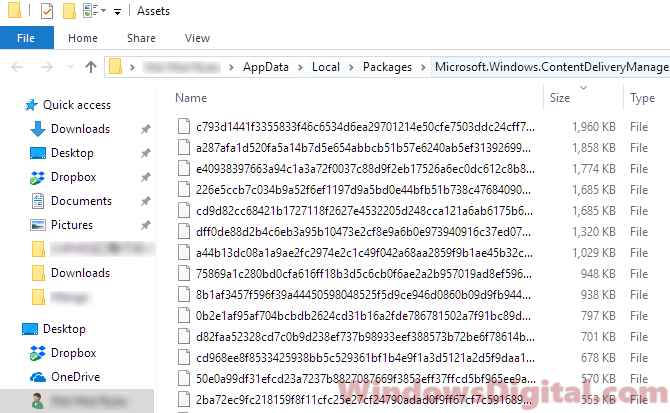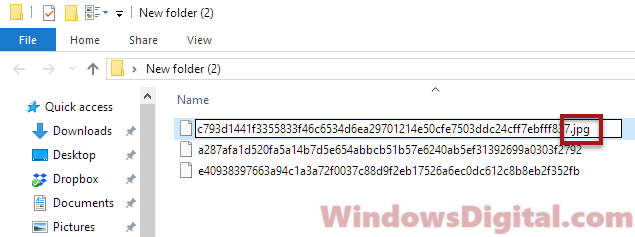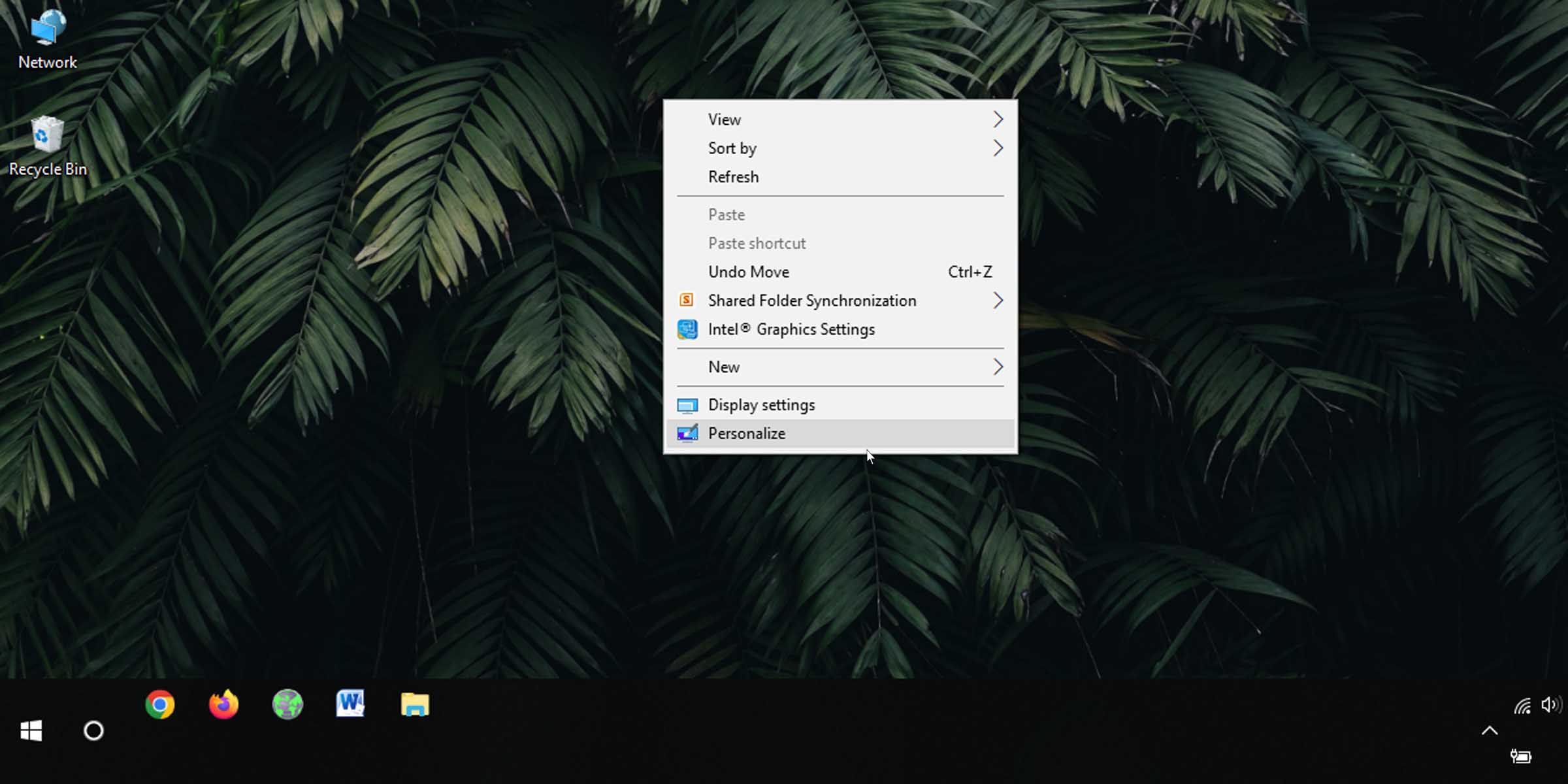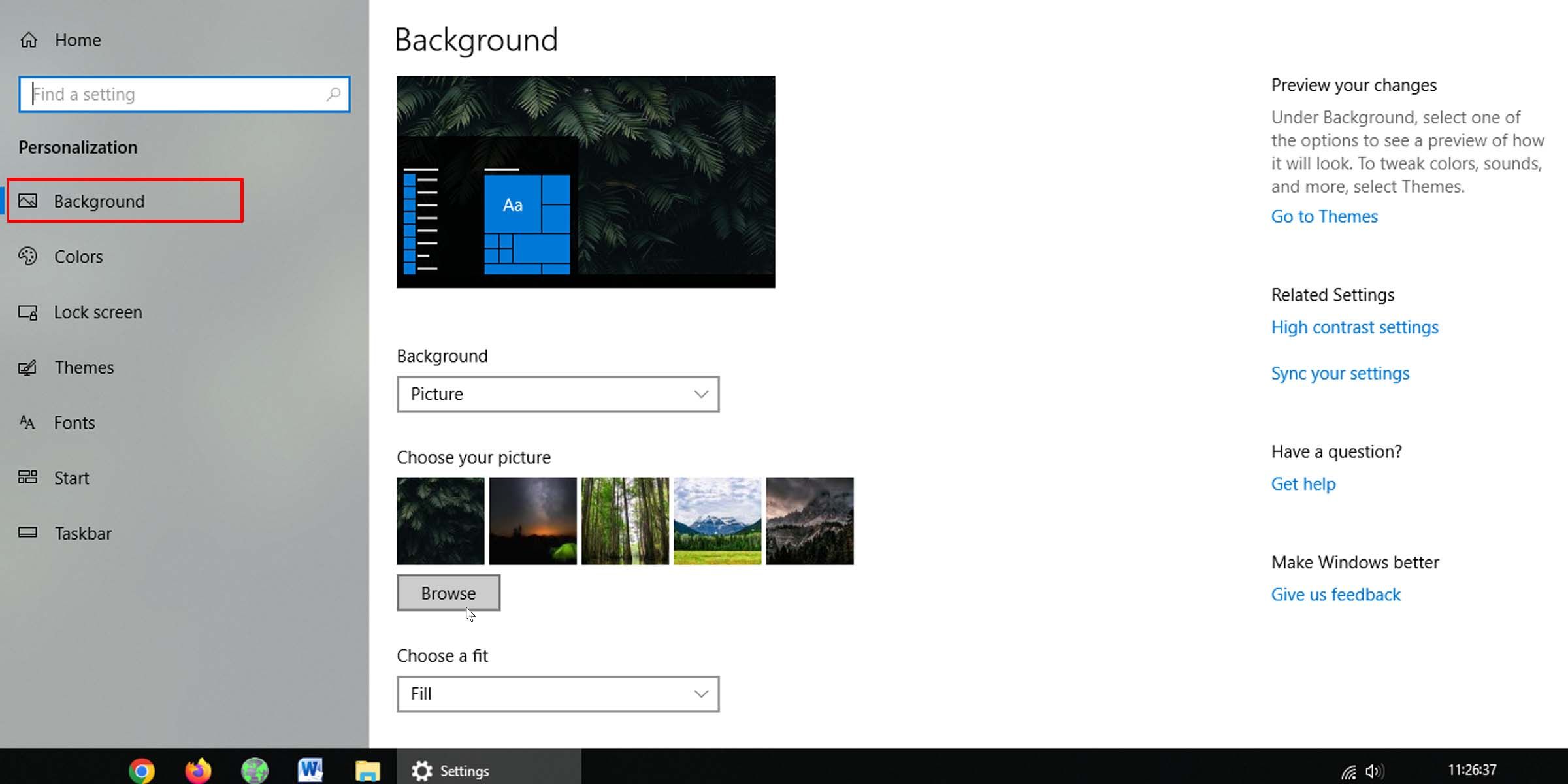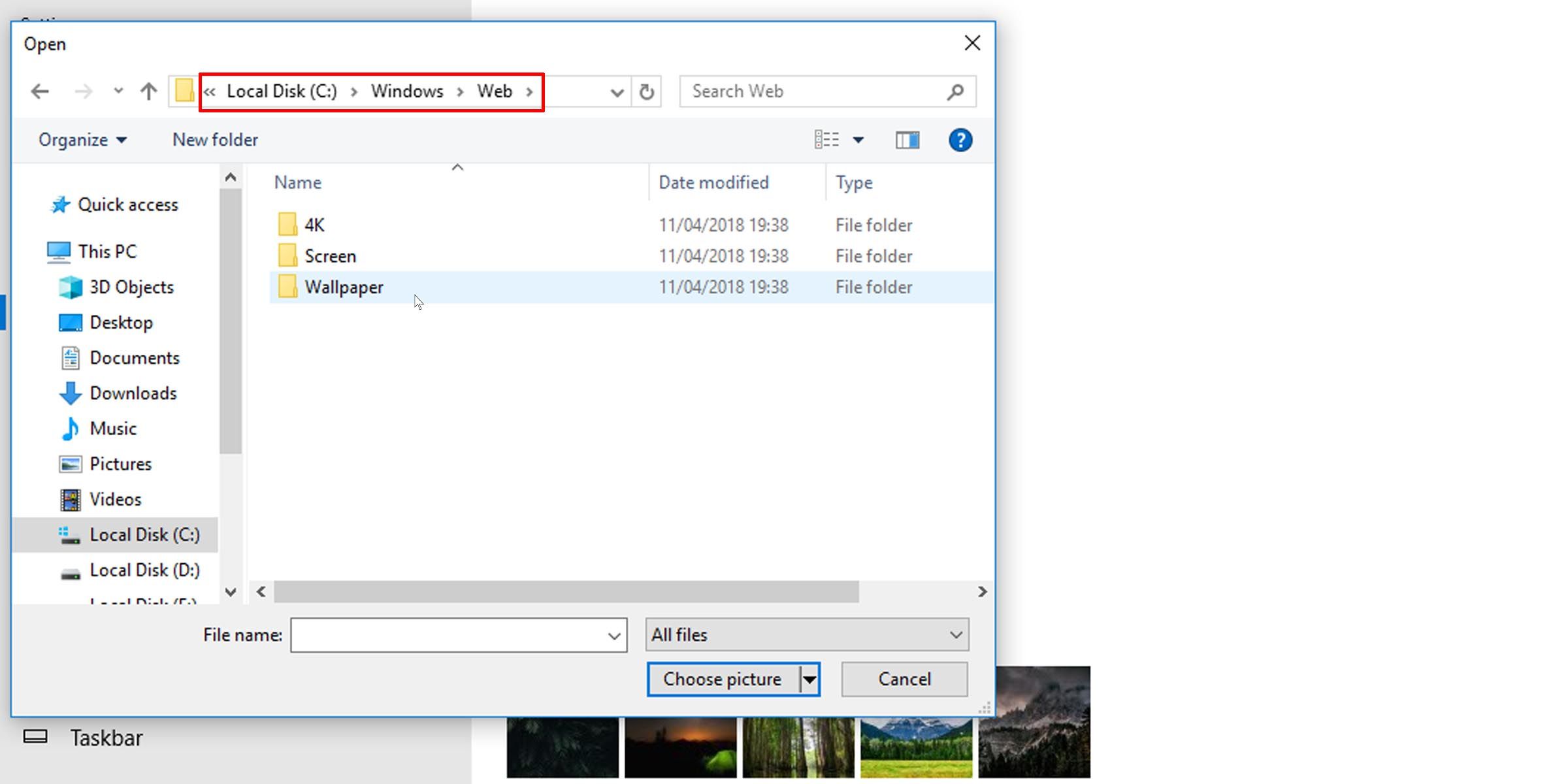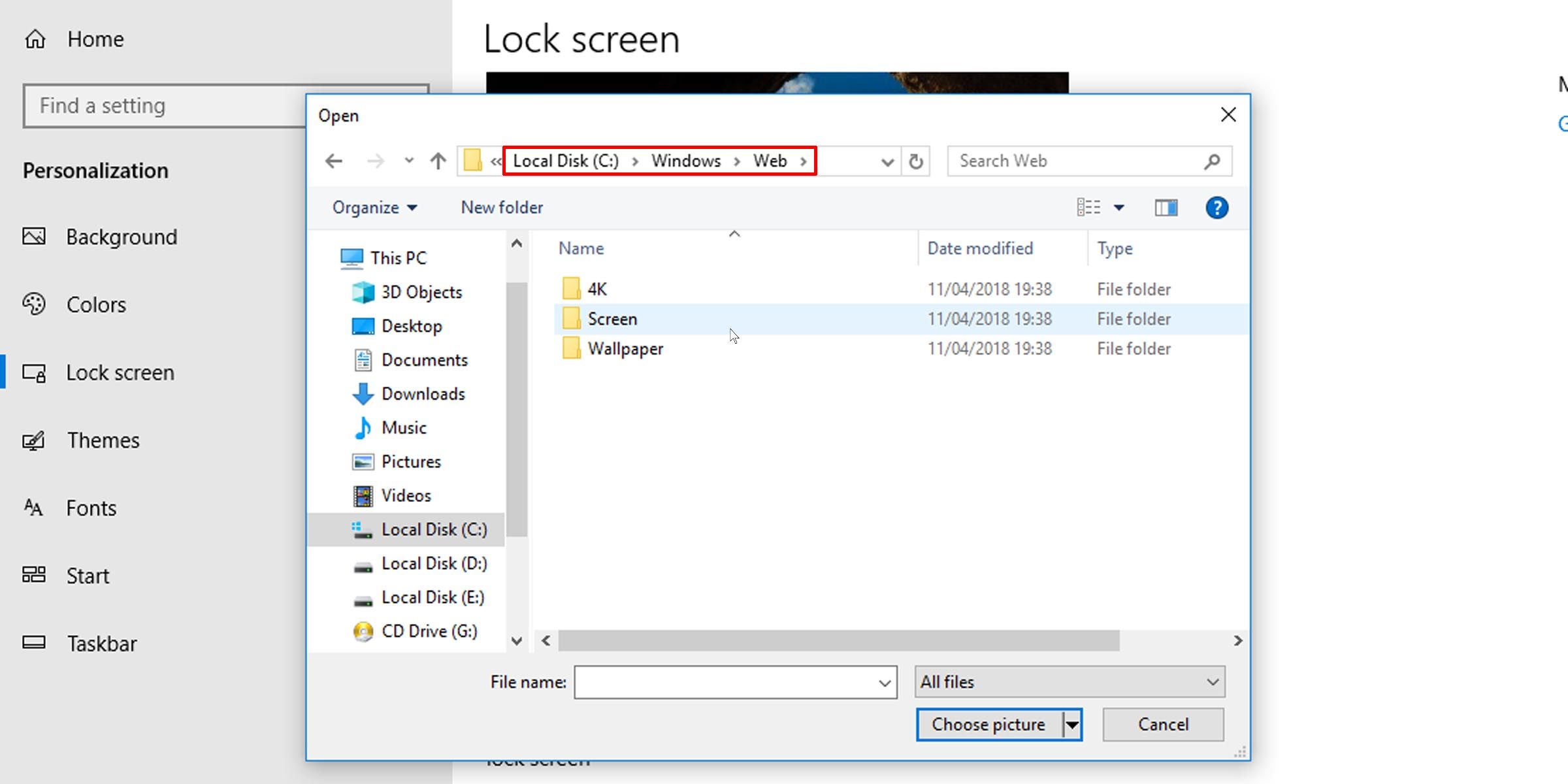The Windows lock screen is the first thing you see when you turn on your PC or wake it up from sleep mode. It displays stunning images from around the world and useful information like the date, time, and notifications. If you want to use these images as wallpaper or admire them in all their glory, this guide will show you how to find the Windows 10 or 11 lock screen images folder location and the actual location of the images in the world.
Also see: How to Find Current Wallpaper Location in Windows 11
Finding the Windows 11 or 10 lock screen images folder location
If you want to extract or copy the lock screen images and use them somewhere else, here’s where you can find them:
- Press the Windows + R to open the Run dialog box.
- Type in the following command and press Enter:
C:\Users\yourusername\AppData\Local\Packages\Microsoft.Windows.ContentDeliveryManager_cw5n1h2txyewy\LocalState\Assets
Replace “yourusername” with your actual username in Windows 11 or 10.
- In the folder, you should see a list of files with random characters and no extensions.
- Sort the list of files by size. Copy files that are at least 500KB in size to any folder you like.
- Right-click each file and select Rename. Add .jpg extension to their names.
- After adding the JPG extension, you should be able to view the images in any photo app.
Note: Before being able to add any extension to any file, make sure you’ve enabled the option to view file extensions by going to File Explorer > View > Options > Change folder and search options > View > uncheck “Hide extensions for known file types“.
The Windows 10 or 11 lock screen images folder location contains only spotlight images that have already been downloaded and viewed at least once on your PC. Any new spotlight photos you see in the Windows lock screen will be added to this folder. Alternatively, you can find the Windows 10 or 11 spotlight images collection online and add them to the folder to allow them to also appear in your lock screen.
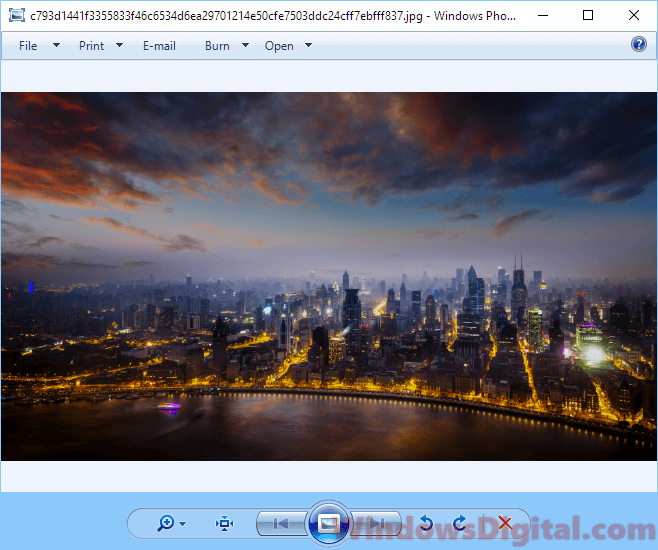
Finding the actual location of the Windows 10 or 11 lock screen images in the world
If you are astounded by the stunning photos that appear in the Windows 10 or 11 lock screen and want to find out the actual location of where these photos were taken in the world, here are a few methods to do so:
View image location info from Windows lock screen
When you’re on the Windows 10 or 11 lock screen, on the top right corner of the screen, there should be actual location info of the current photo with a Like what you see title and options of either I like it or Not a fan. This feature becomes available since Windows 10 v1607 update. If you don’t see the info panel, you may want to run Windows Update to update your Windows 11 or 10.
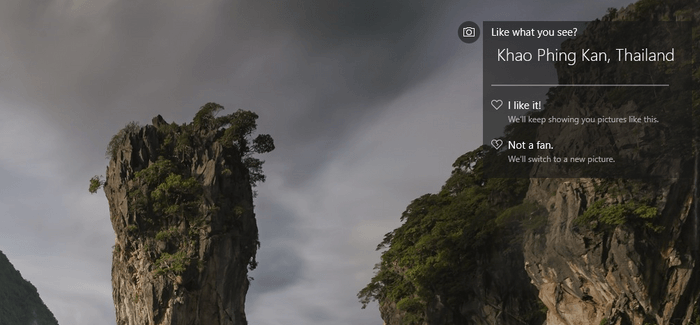
Check the image file properties
Another method to view the actual location of the lock screen images taken is by viewing the file properties. Locate the image files and change the extension to JPG. Right-click the image you want to check the actual location of, select Properties, and then go to the Details tab. You should be able to see the actual location info about the photo under Description.
However, not all images have the location info in the description properties. Some will show an empty description in the Details tab.
Use Google Reverse Image Search
If none of the methods above work to show the location info of the image, you can try to use Google Reverse Image search. Using Google reverse image search can help to find related photos from all around the web and extract the info from relevant websites where the photo was hosted. It works most of the time. To do a reverse search, follow the steps below:
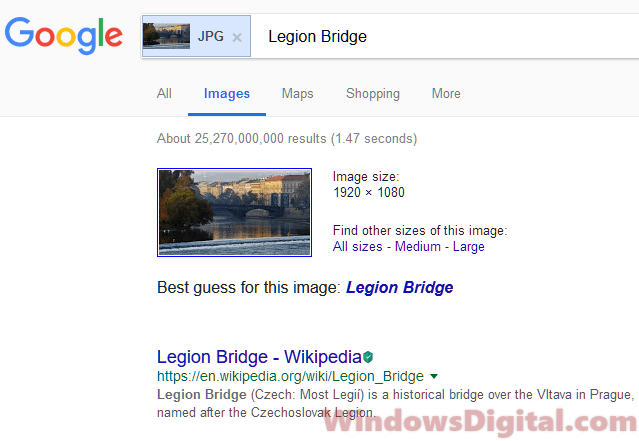
- Locate the image you want to search and add the JPG extension to the image file.
- Go to images.google.com (or see: How to Google Reverse Image Search on Windows 11).
- Upload the image.
- Click on Show matches.
- It should then show relevant info of the uploaded image in a search result.
There are also other reverse image search engines available, such as TinEye and Bing Visual Search, which you can try if Google doesn’t yield the desired results.
One last thing
Keep in mind that while these methods usually give accurate location info about lock screen images, there might be exceptions. Some images are artistically enhanced or might blend elements from different places. So, the data you get might sometimes be more about general inspiration than an exact location. Always double-check the information if you really need to know the precise spot.
После того, как несколько человек в комментариях к разным статьям на сайте написали о том, что делают скриншоты понравившихся обоев рабочего стола из тех, что доступны в Windows 10 по умолчанию, а также посетовали на то, что нельзя сделать скриншот экрана блокировки, решено было рассказать, где хранятся обои рабочего стола по умолчанию, обои экрана блокировки и текущие обои в Windows 10.
Все файлы фотографий и изображений, использующиеся в качестве обоев Windows 10, всегда можно достать из соответствующих папок на системном диске вашего компьютера или ноутбука. Таких папок несколько и именно о том, где их найти и пойдет речь в этой короткой инструкции.
Папка с обоями рабочего стола по умолчанию и с текущими обоями рабочего стола
В Windows 10 присутствует сразу несколько различных папок, в которых находятся фотографии и изображения, которые устанавливаются на рабочий стол как обои.
Далее — расположение этих папок (пути, начинающиеся с указания папок наподобие %LocalAppData% достаточно просто скопировать и вставить в адресную строку проводника, чтобы попасть в нужное расположение):
Где хранятся фоновые фотографии экрана блокировки
Если вас интересуют обои (фоновые изображения) экрана блокировки Windows 10, вы также легко их можете найти. Стандартные обои, присутствующие сразу после установки, расположены в папке C:\Windows\Web\Screen\.
Однако, мало кого интересуют обои по умолчанию, чаще бывают интересны те, что ОС загружает из Интернета. Их вы можете обнаружить в папке
%LocalAppData%\Packages\Microsoft.Windows.ContentDeliveryManager_cw5n1h2txyewy\LocalState\Assets

Просто скопируйте и введите указанный путь в адресную строку проводника, откроется папка, содержащая множество файлов без расширения. Вы можете скопировать их куда-либо и установить для этих файлов расширение .jpg, либо просто открыть с помощью какого-либо графического редактора или программы для просмотра фото.
В указанной папке обычно хранится множество файлов обоев, но, одновременно, там есть и другие, ненужные изображения, не являющиеся фонами экрана блокировки. Если вы хотите добавить расширение .jpg сразу для всех из них и скопировать в папку «Изображения\LockScreen», можно создать и использовать следующий bat файл (см. Как создать bat-файл):
cd /D %userprofile%\AppData\Local\Packages\Microsoft.Windows.ContentDeliveryManager_cw5n1h2txyewy\LocalState\Assets mkdir "%userprofile%\Pictures\LockScreen\" 1>nul 2>&1 copy * "%userprofile%\Pictures\LockScreen\*.jpg"
Sign in to your MUO account
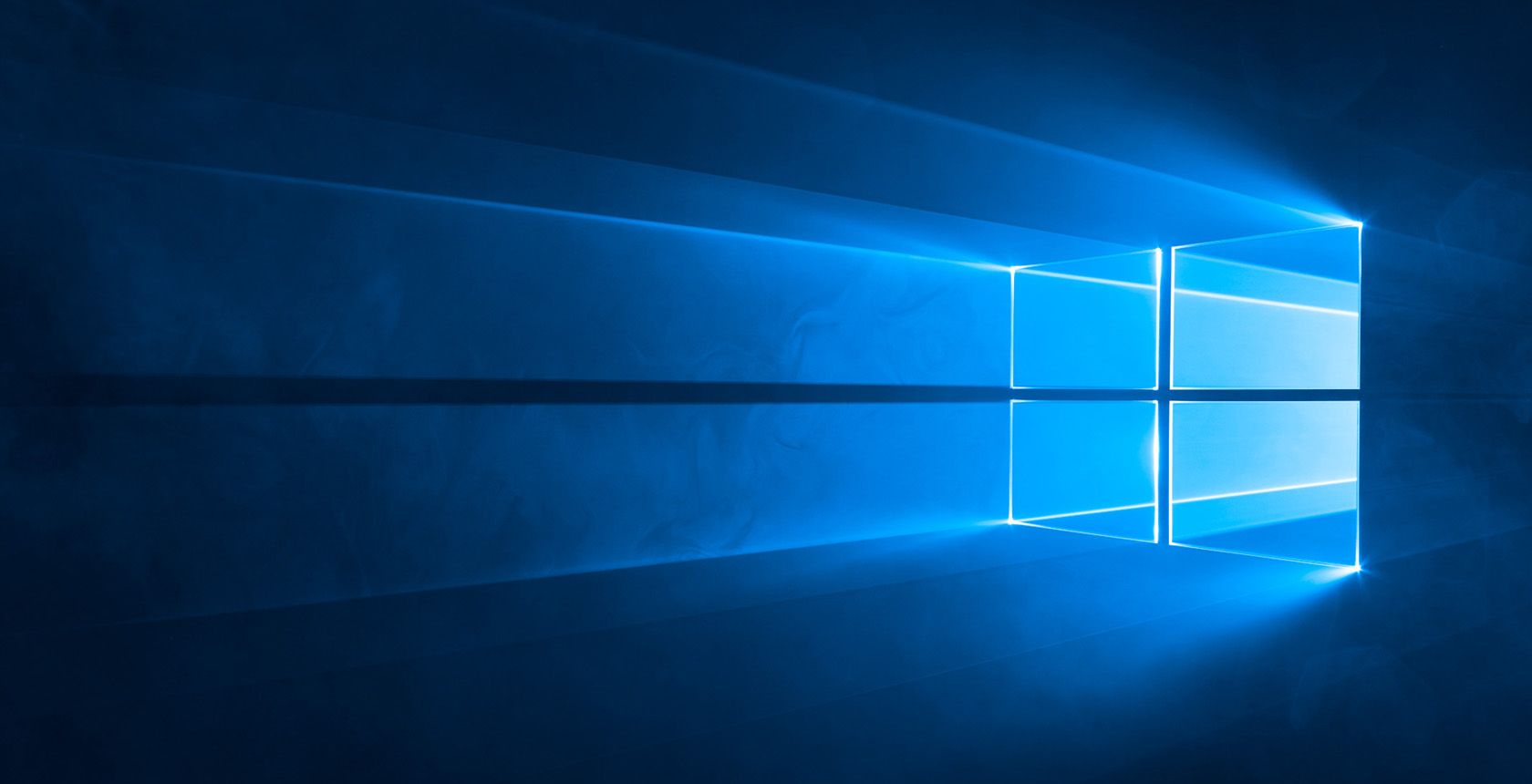
If you like to make your Windows 10 desktop look the best it can be, you may be shocked to learn that Windows 10 only saves the last five wallpapers you’ve used in its recent list. As such, if you’ve changed your wallpaper enough, you can’t switch back to the Windows 10 default wallpapers: There is no reset button to bring back your default wallpapers again.
However, all is not lost. The images are still lurking within Windows 10; you just need to go hunting for them. Here’s where to find the background images that come with Windows 10 if you ever want to switch back to the default.
How to Recover Windows 10’s Default Background Images
You’ll find the background images that came with Windows 10 lurking at «C:\Windows\Web\Wallpaper.» As such, we can navigate the wallpaper picker to that folder and choose the one we want to use again.
- To start, right-click on the desktop and select Personalize.
-
Under the Background option, click on browse.
-
Navigate to the default background image location (C:\Windows\Web\Wallpaper) and select the one you want to use.
You can copy or move the images to a new location, perhaps where you store your other background images. And if you need it, be sure to check out our guide on how to change the wallpaper on an unactivated copy of Windows 10.
How to Get Back Windows 10 Default Lock Screen Images
The Windows 10 log-on screen and lock screen have a unique set of images. The Windows 10 lock screen’s photos were taken at some amazing locations, so it’s worth digging them back up again for reuse.
Much like the wallpapers, the Windows 10 lock screen image location is at «C:\Windows\Web\Screen,» so we just need to repeat what we did for the backgrounds here.
- To change your lock screen image, open the personalization settings as above.
- Then navigate to the Lock screen tab on the left.
-
Under Background, browse to the Windows 10 default lock screen image location and choose which you want to appear when your computer wakes.
Reverting to Default Windows 10 Wallpapers
Windows 10 may not store very many images in its recent lists for desktop wallpaper and log-on screen background, but you can easily retrieve the default Windows 10 images now that you know where they are stored.
Download Windows Speedup Tool to fix errors and make PC run faster
In a previous tutorial, we explained to our readers how to enable Spotlight Feature. This new lock screen feature displays some beautiful images from Bing.com and certain running Windows Apps. However, there seems to be no easy way to download and save the Windows Spotlight dynamic images and set them as your wallpaper or permanently as your Lock Screen.
In Windows 11 and Windows 10, the Wallpapers and Lock Screen images are stored in the C:\Windows\Web folder. But where are the Bing Spotlight images downloaded to? This post will answer this question and show you how to save the Spotlight Lock Screen images in Windows 11/10
What is the Spotlight Lock Screen feature in Windows?
Spotlight is a feature in Windows that allows you to set a beautiful, personalized image as your lock screen background. Once you have enabled the Spotlight lock screen feature, your lock screen will display a beautiful, personalized image each time you lock your computer. However, Windows doesn’t reveal the location of these images, and this post will guide you to finding those image locations.
Open Windows File Explorer, switch to the ‘View’ tab and check the box adjacent to the title ‘Hidden Items’ to force your Windows 10 OS to display all hidden files and folders.

Next, open up the ‘C’ drive (the location where usually your OS is installed) and navigate to the following address:
C:\Users\UserName\AppData\Local\Packages\ Microsoft.Windows.ContentDeliveryManager_cw5n1h2txyewy\LocalState\Asset
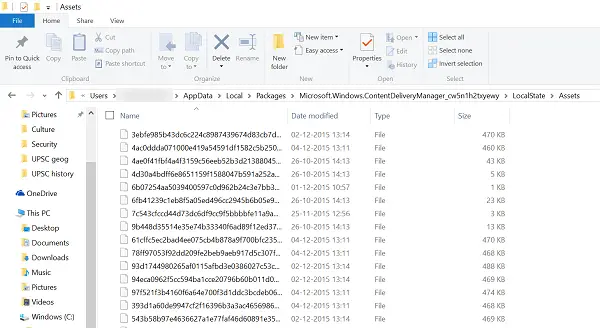
Kindly note that in the above path, in place of UserName type, you own the PC user name.
In the Assets folder, you will find a list of files. Sort them by size, as we will need the large files only. These files represent Windows Spotlight images downloaded from Bing.com. For viewing them, rename each file and use image formats such as PNG or JPG as an extension.
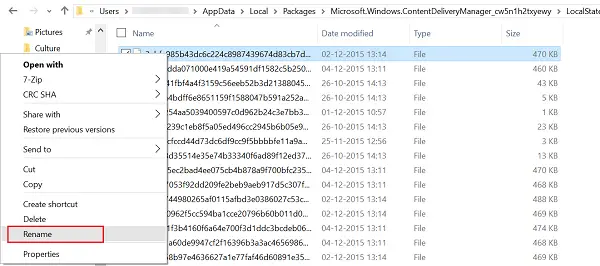
To do this, right-click on a file, select the Rename option, and save them in JPG format. Proceeding in the same manner, you can rename all the files and open them in the default Photos app. Here you can set it as a lock screen or your desktop wallpaper.
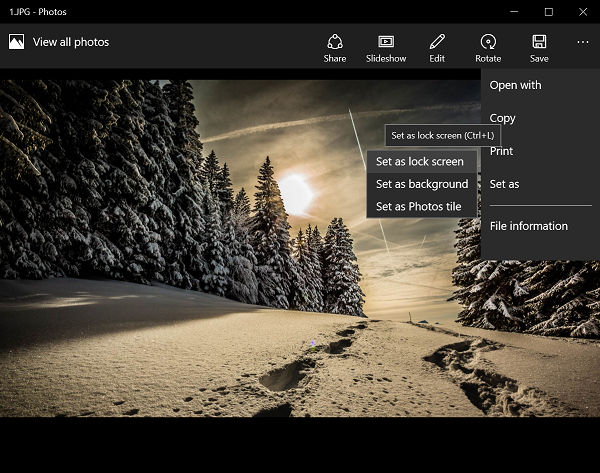
If you find renaming all the files manually a tedious job, this trick helps you batch rename files and file extensions.
You can use the Dynamic Theme app to set Bing and Spotlight images as background or lock screen in Windows 11/10 automatically.
Related read: Windows Spotlight Tool can help you save Spotlight Lock Screen images & use them as Wallpapers.
Anand Khanse is the Admin of TheWindowsClub.com, a 10-year Microsoft MVP (2006-16) & a Windows Insider MVP (2016-2022). Please read the entire post & the comments first, create a System Restore Point before making any changes to your system & be careful about any 3rd-party offers while installing freeware.
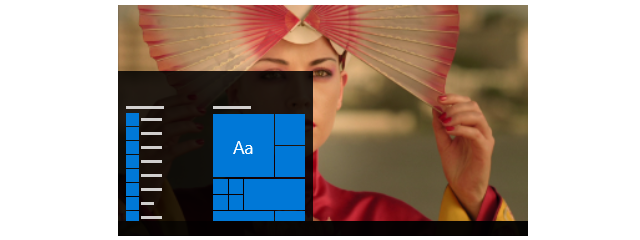
Windows 10 uses impressive pictures for the desktop background and for the Lock Screen. Some of them look great, and we especially like the new default wallpaper for Windows 10 May 2019 Update. If you want to know the location of those images, so that you can use them as wallpapers for other PCs and devices, read this article:
Where to see the background pictures used by Windows 10
Windows 10 uses a set of wallpapers that are found on every PC or device where it is installed. When you open the Settings app, go to Personalization.
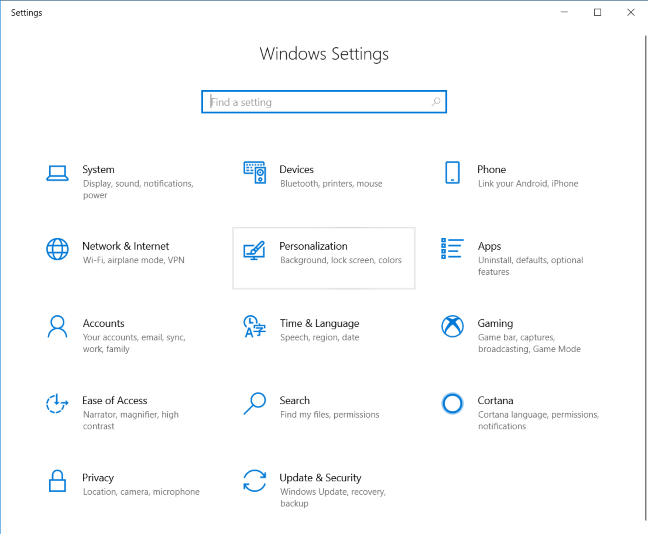
When you select Background on the left, the right side of the window lets you see the pictures used as desktop wallpapers for Windows 10, in the area highlighted below.
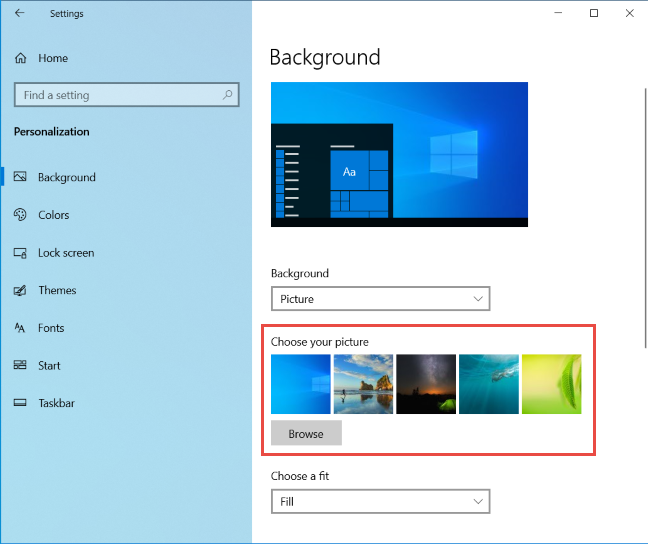
Click or tap on Lock Screen in the column on the left, and on the right side of the Settings window, you see the pictures used by Windows 10 for the Lock Screen.
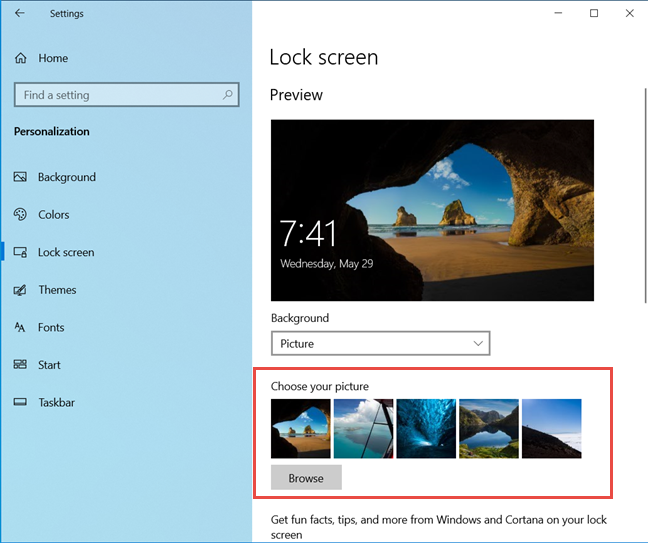
Next, let’s see how to find all these wallpapers on the disk.
The location of the wallpapers used by Windows 10 for the desktop
The location for Windows 10 desktop wallpapers is «C:\Windows\Web». Open File Explorer, go to the C: drive, double-click on Windows, and then on Web. There you find several subfolders: 4K, Screen, and Wallpaper.
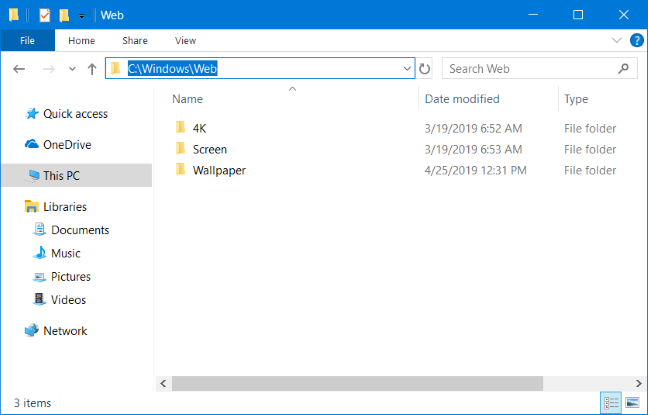
If you open the 4K folder and all its subfolders, you find the wallpaper with the Windows logo, at different resolutions, and aspect ratios. This is the wallpaper used by default for Windows 10 May 2019 Update or newer.
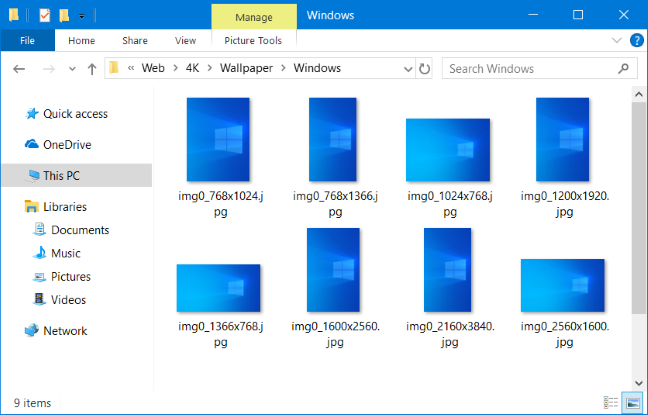
When you open the Wallpaper subfolder, you find other folders:
- Flowers — it contains the standard Windows 10 wallpapers with flowers. There are six of them, all in Full HD resolution or higher.
- Windows — it contains the standard wallpaper with the Windows 10 logo.
- Windows 10 — it has five wallpapers at different resolutions, featuring nature scenes.
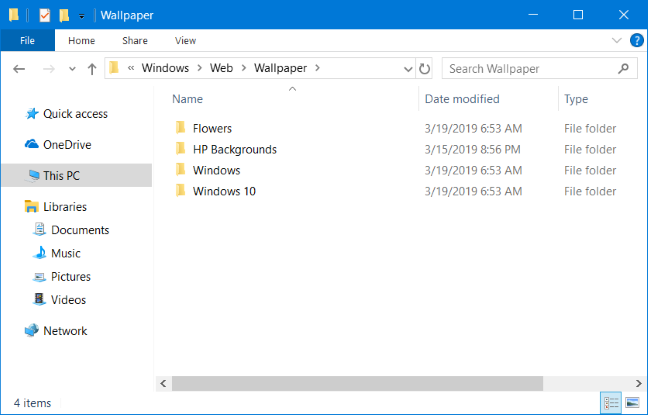
If you have purchased your Windows 10 PC, laptop or device from a manufacturer like HP, Dell, Lenovo, and so on, you may also find a folder created by the manufacturer, with their own default wallpapers. For example, our laptop has an HP Backgrounds folder with a wallpaper created by HP.
The location of the wallpapers used by Windows 10 for the Lock Screen
Windows 10’s Lock Screen wallpaper location is «C:\Windows\Web\Screen.» There you find six wallpapers, all in Full HD resolution or higher.
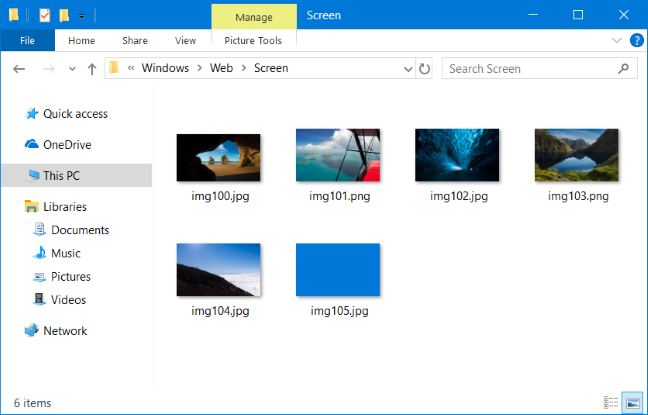
Which Windows 10 wallpapers do you like best?
Navigate through all the wallpapers that are bundled with Windows 10, and tell us which you like best. What do you think about the new wallpaper from Windows 10 May 2019 Update? We like it a lot more than previous versions, as it looks more optimistic and modern. Comment below and let’s discuss.
Subscribe:
RSS Feed
Google News
YouTube

